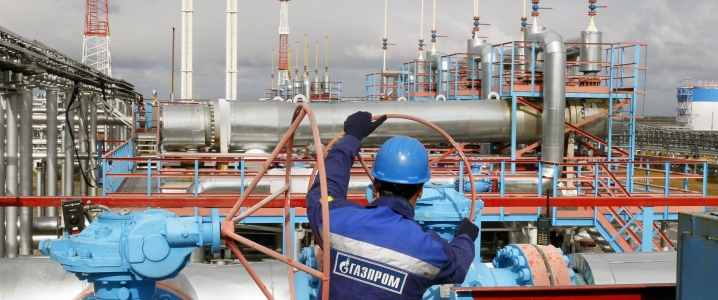The UK is receiving two Russian LNG cargos this week after a rare cold spell caused by freezing winds from Siberia. Some might see a cruel irony in that: Siberian winds highlight Gazprom’s dominance in Europe. Irony or not, however, this is the truth to date, as painful as it may be too many in Europe. As Gazprom’s CEO Alexei Miller put it, there is no other gas supplier to the continent and the UK that can ramp up deliveries so quickly.
This state of affairs is certainly a challenge for the European Union. It has been trying to diversify its gas supplies away from Russia, intensifying these efforts after the gas war between Russia and Ukraine in 2010 that led to supply outages in Europe. This gas war has flared up again in recent days after the Stockholm Court of Arbitration ruled in favor of Ukraine’s Naftogaz, slamming Gazprom with a more than US$2-billion bill.
The EU has wasted no time calling on the two countries to settle their differences. After all, like it or not, more than 40 percent of Russia’s European gas deliveries pass through its estranged eastern neighbor. Russia certainly doesn’t like it. Neither does Europe. For the former, this is too great a dependence on Ukraine, especially since bilateral relations are unlikely to change for the better anytime soon. For the latter, this is too great a dependence on Russian gas.
Both are working to change the situation. Russia has plans for two more pipelines—Nord Stream 2 and Turkish Stream—and the EU is building the Trans-Adriatic pipeline that would supply gas from the Caspian Sea to the continent. TAP is, however, several years away from completion, and the project has gone anything but smoothly. LNG supplies are an alternative, but again, Russia has the edge: the Yamal LNG terminal is closer to Europe than any other supplier’s facility. Related: Chevron: We Will Survive Under Any Climate Change Scenario
The diversification problem is aggravated by the fact that Germany wants Nord Stream. In fact, it needs it as the government makes vow after vow to get rid of coal and nuclear power. These need to be replaced by something, and this something is gas. Lots of gas. Norway can’t deal with this spike in German gas demand alone. Russia can, so Germany wants Nord Stream 2. The Baltic States, however, don’t. They are worried about their energy independence, however much of it they have since they, too, rely predominantly on Russian supplies.
But this dependence is mutual. Europe—EU and the Balkans—is Gazprom’s biggest client for the moment and likely to remain so in the foreseeable future despite Moscow’s Chinese pivot. Much as been said about Russia’s willingness to use gas as a political tool; the Stockholm court’s ruling has shown that this is not so, just as have demands from the EU that have forced Gazprom to revise some of its supply contracts.
For Gazprom, building Nord Stream 2 to divert part of gas supplies from Ukraine is just as urgent as it is for Europe to get Caspian gas flowing in. Yet even after TAP is completed, Europe will have to rely on Gazprom for much of its gas needs, just as Gazprom will have to rely on Europe for much of its export income. The Beast from the East simply reminded both that they can’t divorce just yet.
By Irina Slav for Oilprice.com
More Top Reads From Oilprice.com:
- Shell Takes Major Steps Toward Energy Diversification
- One Of The World’s Largest Crude Storage Facilities Has Been Emptied
- Trump’s Trade Wars Could Spark A Massive Drop In Oil



















Russia is already building two more gas pipelines: the Nord Stream 2 and the Turkish Stream to ensure Russian gas supplies to Europe are not vulnerable to disruption through the Ukraine.
The US has always been opposed to Nord Stream II, which it views as Russia’s attempt to solidify its hold on Europe’s energy supplies.
In fact, US misgivings about the geopolitical implication of Nord Stream II are shared by eight European countries (perhaps instigated by the US) – Poland, Hungary, Lithuania, Latvia, Estonia, the Czech Republic, Slovakia and Romania. They strongly believe that Nord Stream II would undermine the energy security of Central and Eastern Europe, and detrimentally impact Ukraine.
But the prospective shareholders in the Nord Stream II consortium (Gazprom 50%; E.ON 10%; BASF/Wintershall 10%; Royal Dutch Shell 10%; OMV 10% and Engie 10%) argue that Nord Stream II would enhance Europe’s long-term energy security by providing an alternative gas supply route that avoids the unreliable transit state of Ukraine.
When completed probably by the end of 2019, Nord Stream II will transfer 27.5 billion cubic meters a year (bcm/y) of gas, doubling the capacity of the Nord Stream I. Germany could be the biggest beneficiary of Nord Stream 2.
Cultivating this dependency is a conscious move by Russia. Russia has developed economic leverage that enables it to exert pressure over countries that could pose a danger to it by threatening their energy security. Is this just business for Putin? Of course not; geopolitical interests are intertwined.
Dr Mamdouh G Salameh
International Oil Economist
Visiting Professor of Energy Economics at ESCP Europe Business School, London